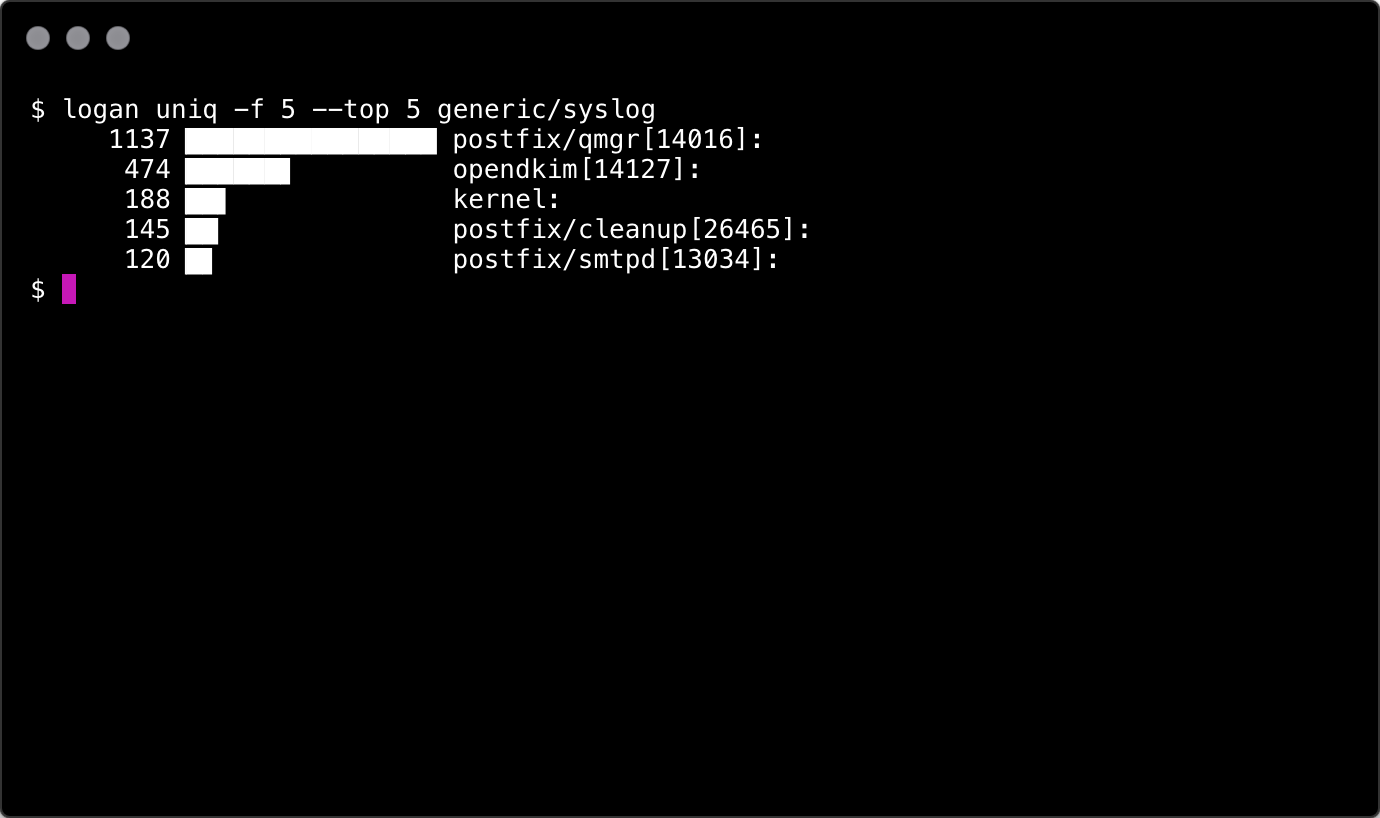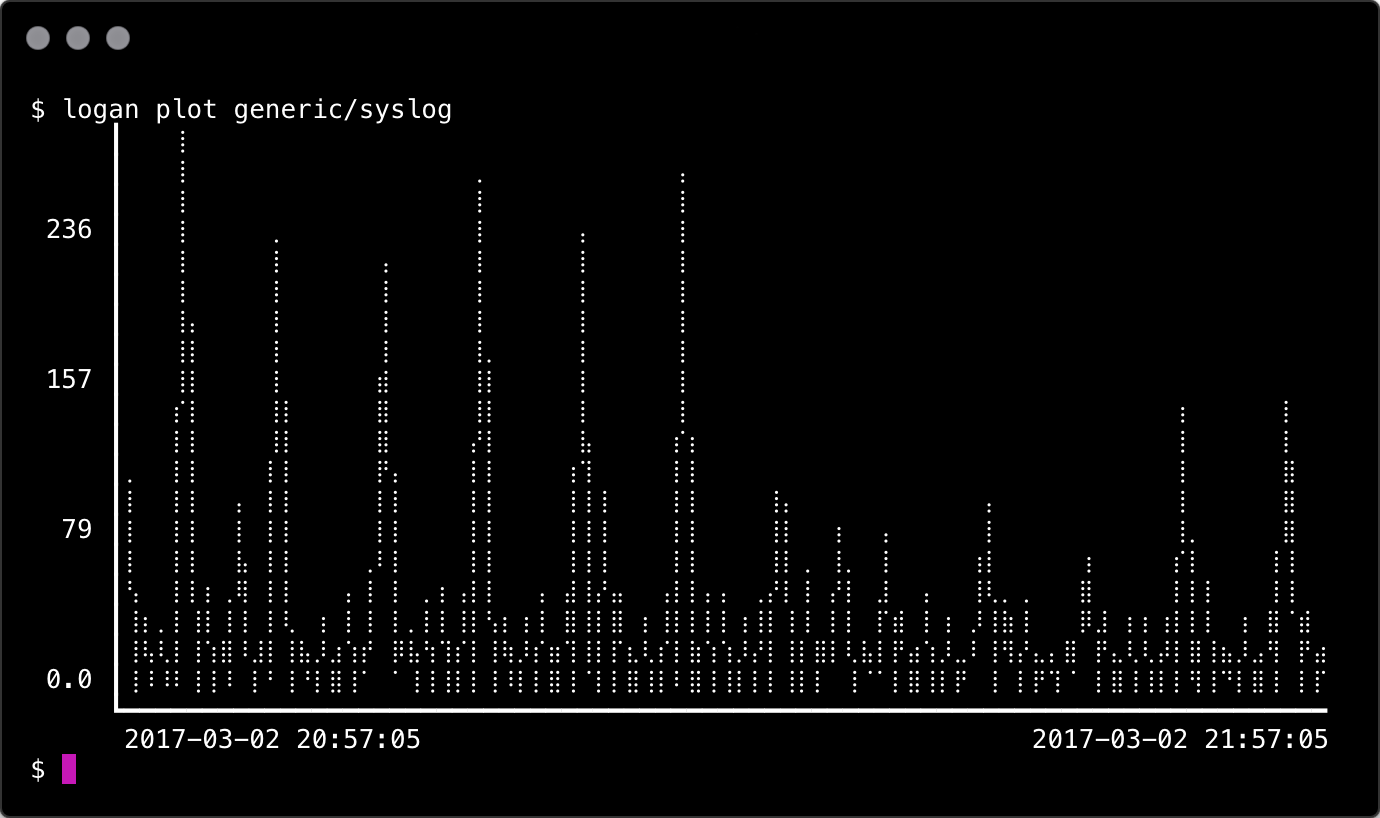Terminal-based tool for analyzing logs on the fly.
go get github.com/kbence/logan
logan list [query]
logan (inspect|show|uniq|plot) [options] <category> [filter]
The list subcommand can be used to list all available log categories. Categories are organized into groups, based on their sources, the currently supported groups are:
generic/*- logs found in/var/logscribe/*- Scribe-style logs, found in/mnt/scribeand/var/log/scribeby defaultstdin/-- logs read from standard input
Commands accept the full name (e.g. generic/system) or category only, if it's not ambiguous (e.g. system). Currently short versions of categories containing the / character are not supported.
These options can be used to every commands but list. Well, there are some exceptions, see the descriptions for details.
Shows possible options for each commands.
This option is a bit tricky, but one of the most important one, it's good to understand how it works. It consists of 3 components: reference time, negative offset, positive offset.
The reference time is the exact time in the format HH:MM or HH:MM:SS, it's the current date if omitted. It is followed by the negative offset, a duration string which moves the beginning of the interval back relatively from the reference. If omitted, is -1h. Then the positive offset is another duration, which defines the length of the time interval from the beginning (marked by the reference time and the negative offset). It'll be the current time if omitted.
Duration is a string of concatenated numbers and suffices. The supported suffices are s (second), m (minute), h (hour), d (day) and w (week). Micro- and nanoseconds are supported as well (ms and ns respectively), but they are not really useful (the implementation is a modified version of Golang's ParseDuration, extended with support for weeks)
Example time intervals:
-3h5m: the last 3 hours and 5 minutes (from-3h5mto now)-1w: the last week (168 hours)18:00: since the last 18:00 (e.g. 5 minutes when executed at 18:05, 23 hours and 55 minutes when executed at 17:55)12:00+5m: from the last 12:00 to the following 12:0512:00-1w+5m: the same but one week earlier
When set, only the specified fields will show up in the output. Particularly useful for the command uniq. It can be used for every command except list and except.
Fields are parsed with a simple algorithm, strings between quotes (""), apostrophes (''), brackets ([]), parentheses (()) are considered one field. If not quoted, fields are strings separated by multiple tabs or spaces (in any combination). The output (even for show) omits multiple spaces, so the fields will always be separated by a single space.
Fields can be specified one by one (e.g. 1,2,5,7,2) or in ranges (1-8,3,4-6).
Prints the first five lines that matches the filters and time specifiers. First the whole line, then separated to fields, wit every fields marked with their number. Useful to write filters.
Example:
$ logan inspect generic/syslog
Line: Mar 2 20:31:01 servername CRON[27049]: (www-data) CMD (/usr/local/bin/some_cronjob.sh )
1: Mar
2: 2
3: 20:31:01
4: servername
5: CRON[27049]:
6: (www-data)
7: CMD
8: (/usr/local/bin/some_cronjob.sh )
The main purpose of this command is to inspect the log lines themselves and to be able to feed the filtered output to other commands (e.g. less/vim for viewing/further processing).
The following command will show log lines from /var/log/syslog for the last hour.
# logan show generic/syslog
This command can show a summary of the log by counting unique lines and showing them with nice unicode bar of ratio.
-top is an additional option that only makes sense here, it specifies the top N hits in uniq's output.
Example:
The above command counts the unique number lines grouped by field 5 from the last hour's data of /var/log/syslog.
Based on the current filters and time specifier, this command draws up a single chart based on your terminal's dimensions (using 80x25 by default if it cannot be determined).
-m specifies the character set for plotting, the following sets can be used:
braille- Braille characters, multiplies the horizontal and vertical resolution by 2 and 4 respectively.quad- unicode block drawing characters, the doubles the resolution in both directions.block- use the block drawing characterclassic- use ASCII7 characters only (pipeline, apostrophe, point and the classic box drawing methods).
Example:
Filters can be used for all the commands above except list. A filter consists of one of more expressions connected with the AND and OR logical operators. The currently available operators are ==, !=, ~= meaning equality, non-equality and pattern match respectively. Pattern match is done by Go's regular expressions.
Currently only string literals are supported as values, surrounded by quotes. A few example filters:
$12 == "404"- field 12 is exactly the string404$5 != $7- field 5 doesn't equal field 7$10 ~= "^https:" AND $11 == "123"- field 10 starts with the stringhttps:and field 11 is exactly123
Multiple filters can be specified, in this case they act like there are AND operator between them (although under the hood, new filter instances are being created).
IMPORTANT! In most of the shells, strings like $1, $2, etc. are expanded as variables unless they are properly escaped (e.g. with apostrophes or backslashes). The current solution is to put them in apostrophes, like this:
logan show generic/syslog '$4 == "myhost"'
The field marker character ($) and the regexp matcher (~=) are subjects to change in the future.

